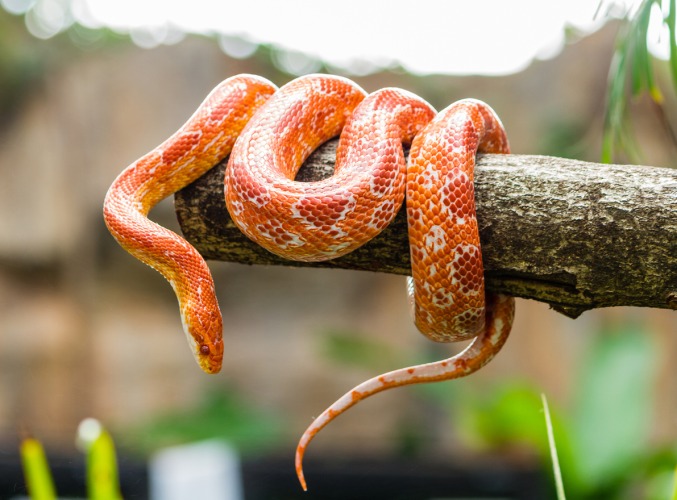There’s nothing worse than encountering a potentially deadly snake while working or playing outdoors.
The state of Illinois is home to a large variety of non-venomous snakes, like the well-known Garter Snake and the Dekay’s Brown snake.
If you live, work, or play outdoors in Illinois, it makes sense to learn about the local wildlife you can encounter while hiking, walking, or camping in the area.
This guide provides an overview of some of the most common and deadly snakes that can be found in Illinois.

Contents
So… Are There Snakes in Illinois?
Yes, there are snakes in Illinois!
Illinois has a variety of over forty different snake species living within its borders.
The most common snake found in Illinois is the Common Garter Snake.
Most snakes found within the state aren’t venomous – but there are a few slithering serpents that local hikers and nature enthusiasts should steer clear of.
Snake Species in Illinois
Illinois is home to forty different snake species.
The snakes below are most commonly seen slithering around large and small towns.
- Common Garter Snake
- Copperhead Snake
- Dekay’s Brown snake
- Gray Rat Snake
- Northern Cottonmouth Snake
- Timber Rattlesnake
Illinois Snakes by Region
- Central Illinois: Common Snakes – Garter, Brown snake
- Northern Illinois: The Massasauga Snake is a highly venomous snake found in the Northern regions of Illinois along with a variety of common snakes.
- Southern Illinois: This area is home to some of the area’s venomous and non-venomous snakes. We find the Copperhead, Cottonmouth, and Timber Rattlesnake in the southernmost areas of the IL.
- Western Illinois: Common Snakes – Grey Rat Snake, Dekay’s Brown snake
Venomous Snake Species in Illinois
There are four known venomous snake species in Illinois.
These venomous serpents belong to the Viperidae Family of venomous snakes found throughout the region.
The Illinois Reptile Guide offers an easy way to identify venomous snakes by paying attention to the shape of their pupils.
- Copperhead Snake: The proper name of Copperhead snakes found in IL is Agkisdtrodon Contortix. This snake is identifiable through its rust-colored back and brown or yellow belly. Illinois Copperheads are found entangled in heavily wooded areas, perched along rock hillsides, and on the outer edges of thick forests.
- Massasauga Snake: Locals say that the Massasauga used to be found in only the northern two-thirds of the Prairie State. We now find this venomous IL snake in Western, Central, and Southern Illinois. Sistrurus catenatus is characterized by nine evenly spaced plates on its head, dorsal blotches, and its solid black tail.
- Cottonmouth Snake: Illinois Cottonmouth snakes are found in the southernmost counties in the state. Local cottonmouths go by the official name of Agkistrodon piscivorus. Juvenile snakes of this variety can be identified by dark or olive-colored crossbands on their backs. Adult cottonmouths are usually solid black or olive with a tan or grey belly.
- Timber Rattlesnake: Crotalus Horridus is the proper name of IL’s endangered Timber Rattlesnake. This venomous Midwestern snake has a small head with a light yellow, greenish-white, or gray back. Illinois’ most endangered snakes can be found on rocky outcrops and bluffs in and around heavily forested areas.

Is it Safe to Go on a Trek in Illinois?
Going on a leisurely nature trek in Illinois is generally safe as long as hikers follow a few common-sense safety precautions like wearing hiking boots and carrying an emergency kit.
Hikers in Southern Illinois should be more cognizant of their surroundings when spending time in nature as three out of four of this state’s venomous snakes are found in this region.
Learn about more safety tips for enjoying the outdoors in Illinois below.
Interesting Snake Facts in Illinois
The state snake of Illinois is the Eastern Milksnake.
Illinoisians can easily identify venomous or non-venomous snakes by paying attention to the shape of the snake’s pupils.
Snakes in Illinois come in a range of different sizes.
The smallest snake reported in the region measures only 8 inches long.
Illinois’ largest snakes can be as long as 7 feet.
Snakes biting people in Illinois is a rare occurrence.
Most snake attacks happen as a result of people attacking, pestering, or attempting to relocate snakes from their natural habitats.
3 Safety Tips for Exploring Nature in Illinois
Planning a nature hike or camping trip in Illinois can lead to fun adventures and lasting memories.
Follow the tips below to stay safer when exploring nature in Illinois.
1. Keep Your Campsite Clean
Illinois camping enthusiasts can keep their tent sites relatively serpent and wild animal-free by keeping their campsites clean.
Use vacuum-sealed food containers to avoid attracting unwanted attention from wild animals and snakes and place food waste in properly sealed receptacles.
2. Never Feed Wild Animals
Feeding wild animals while hiking or camping in Illinois’ thick forests can be an immediate recipe for disaster.
Sharing your food with woodland creatures can attract larger and more dangerous animals to your camper or tent.
3. Pay Attention to Your Surroundings
Always pay close attention to your surroundings when hiking, camping, boating, and fishing in IL.
Many outdoor predators can easily blend in with the scenery and go unnoticed until excited adventurers find themselves standing face-to-face with hidden and cliff-dwelling animal species.
Summary
Now that you understand where to find some of the most venomous snakes in IL and how to identify these local slithering citizens, you can feel more confident when hiking through off-the-beaten pathways and in nature preserves throughout the state.
Avoid becoming the victim of a venomous snake bite by paying close attention to its pupils, signature markings, and overall color.
Outdoor explorers should always adhere to common sense tips when hiking, fishing, boating, or working outside.
Illinois Safety Overview
READ THE FULL REPORT: Illinois Safety Review
Safety Index:
- OVERALL RISK: MEDIUM
- TRANSPORT & TAXIS RISK: MEDIUM
- PICKPOCKETS RISK: MEDIUM
- NATURAL DISASTERS RISK: LOW
- MUGGING RISK: HIGH
- TERRORISM RISK: MEDIUM
- SCAMS RISK: MEDIUM
- WOMEN TRAVELERS RISK: LOW
Frequently Asked Questions
How many people die from snake bites in Illinois?
The Illinois Division of Research Safety and the CDC report an estimated eight thousand venomous snake bites happen each year.
Venomous snake bites can leave bite victims feeling disoriented with cloudy vision and a metallic taste in their mouths, but not all venomous bites are deadly.
Luckily, the CDC states that only about five people die each year from snake bites in the US.
Where do Illinois snakes like to hide out?
Nature lovers, campers, hikers, and other outdoor enthusiasts typically snakes and creepy crawlers slithering around in thick lush forests, hiding in heavily wooded areas, perched inconspicuously along rocky cliffsides, and camouflaged by falling leaves and brush found at the edges of local forests.
What should I do if I get bitten by a snake?
The first thing to do if you get bitten by a snake is to get as far away from the snake as possible — then call local authorities and get to your nearest emergency room for help.
What is the largest snake found in Illinois?
The Timber Rattlesnake is one of IL’s most venomous snakes.
It is also the largest snake on record measuring up to sixty inches long.
Timber Rattlesnakes are typically found in the southernmost counties.
Hikers and campers who encounter this highly venomous and gigantic snake species should steer clear.











